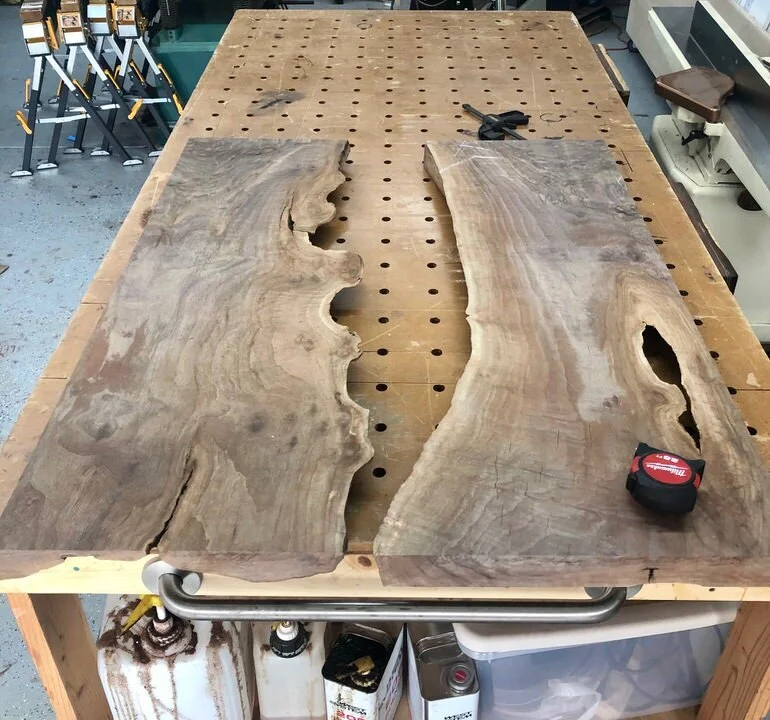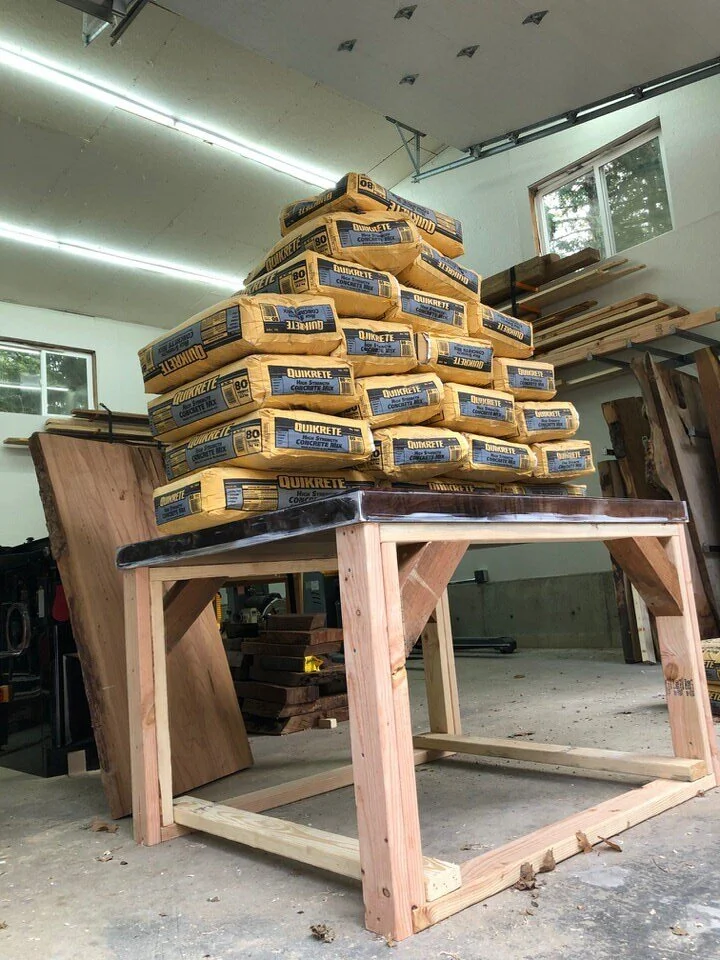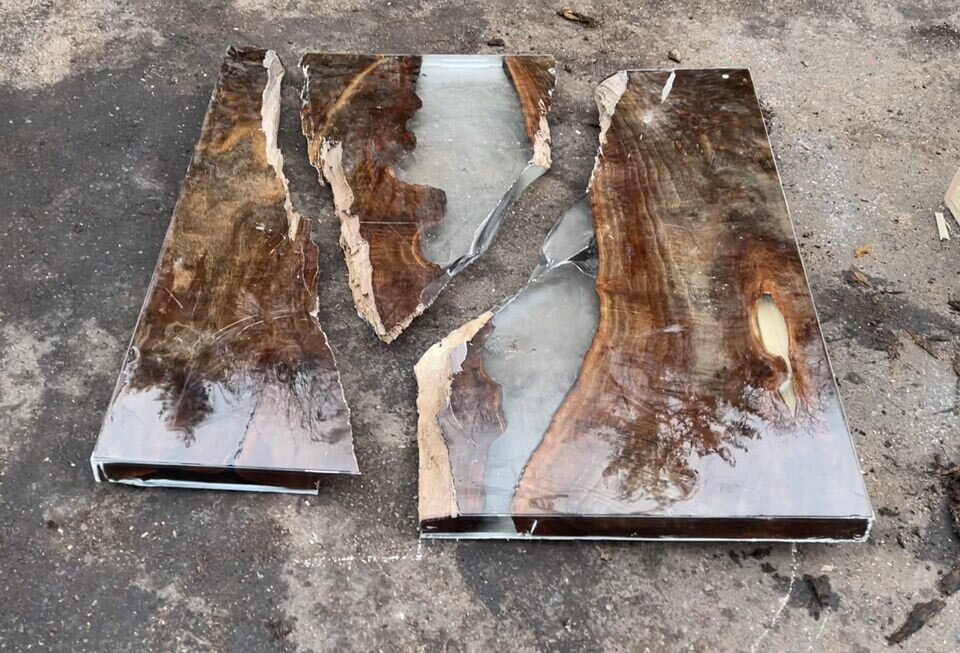How Strong is an Epoxy Table?
How strong is an epoxy table?
This was a fascinating question for me. Because I genuinely didn't know the answer. I had my suspicions but had never actually tested the wood-epoxy bond before. So I decided to build a table, just to break it.
The table I am going to break
The Wood
Kinda funky walnut slabs for this epoxy table
The wood I decided to use was, not surprisingly, Black Walnut. The vast majority of my tables are Walnut. So I figured that would be the best species to experiment with. Goby Walnut donated a kind of funky 2.5" slab that they said didn't have much value. So while it might not win me any design awards, it will be perfect for this test.
I split the slab down the middle and just flipped the outside edges to the inside. Then I built a form, set the slabs inside, then poured about 30 liters of epoxy. Before you ask, I didn't seal my edges! This was clear epoxy, so no risk of staining. I was also planning more of a weight/impact test. Not wood movement over the years test. However, I do plan to do that test eventually.
I made sure my epoxy was fully cured before doing this test. Generally, I like to let tables cure for a month or so before finishing them. This allows for the epoxy to reach maximum strength. The epoxy also will continue to shrink a tiny amount as it cures. So finishing too early can lead to a "wrinkly" finish.
The Legs
I didn't want to spend a ton of time or money on the legs So I decided to build the legs from fir framing studs. Ugly, but strong (and cheap).
To ensure this test was as epoxy-centralized as possible, I didn't want any direct support under the river portion. Even though a normal epoxy table would likely have such support. I decided to make U-shaped legs that ran the table's length—then connected underneath to provide the necessary stability.
The Epoxy
As I have mentioned before, not all epoxy is created equally. There are tons of discount brands out there trying to capitalize on the epoxy table goldrush. I am using Liquid Glass deep pour epoxy by FGCI for this test. It is the only brand that I have used and never had a single issue with. I’m always quick to mention that I am a brand ambassador for Liquid Glass though. So don’t take my word for it. Do your own research, this is not the only acceptable brand out there. However, it is the best brand that I have found so far.
The first test
1680 lbs of concrete on this epoxy table.
What seems to be the most common fear for epoxy table owners is “What if my drunk uncle leans on an unsupported section of the table, will it break off?” Ok, I’m paraphrasing a little. But you get the idea. Anyway, I decided to perform an exaggerated version of this situation.
I rented 25 80 lb sacks of concrete from Home Depot (purchased them with the intent of returning them). I then proceeded to stack them on the very center of the table. Doing my best to concentrate all the weight directly on the epoxy. Before you ask, when I returned them I stacked them neatly right where I got them. I’m not an animal that would just leave them at the returns counter.
Results
I was only able to get 21 of the 25 sacks on the table before I ran out of height. I probably could have gotten the last few on top, but I was nervous of them tipping over onto my ladder. Or something catastrophic like that. Either way, the table held up 1680 lbs of concrete without even bowing in the middle.
The Second Test
Walnut log that weighed in at over 2000 lbs didn’t have much effect on this resin table
It was clear at this point that I wasn't going to be able to break this table myself. Short of bringing out the munitions anyway. The owner of Goby Walnut said that they would be happy to volunteer their men and machinery to get this table broken. One way or another.
I had grand ideas of getting bigger and bigger logs on the table until something just gave way. Unfortunately, that was a little harder to do in practice. The biggest log Goby was able to balance on the center was a green walnut log that weighed just over 2000 lbs. Don't get me wrong, that's a lot of weight. Just not a lot more than the concrete sacks I had already done.
Results
As you might have guessed, the table held up fine with a 2000 lb walnut log balanced on top. We were able to set it directly on the middle, with only one portion leaning on the wood. Just like the concrete test, no sagging or hint that the epoxy might break.
Final test
I dropped the table off at Goby about two weeks before this test. In part because I needed the space in my shop. But also to get the creative juices flowing for those guys. I knew somebody would come up with something if they had a couple of weeks to stew on it. Sure enough, they did.
The manager of Goby had taken some time to sharpen an 840 lb oak log to a point with a chainsaw. He then attached a couple of eye bolts to the other end. The idea is to suspend the log with parachute cord from a forklift, then have someone else cut the line from a basket raised from another forklift. Picture the last scene in Predator. Only instead of an alien, you have an epoxy table.
Results
If you haven't watched the video yet, now would be a good time. My storytelling could never do this justice. Either way, the log blew right through the table like it wasn't there. It splintered the table into three main pieces. However, that is where things got interesting.
The table broke into three distinct pieces. However, at no point did it break at the wood/epoxy bond, which was a surprise to me. The log landed directly on the epoxy. It broke across the epoxy at that point, as well as breaking the entire length of the slab along the wood grain. It even broke at another point across the wood. But again, never at the wood-epoxy bond.
So what does this tell us? The epoxy-wood bond, and epoxy itself, is at least as strong as the wood. In this case, Black Walnut, which is a very strong wood. So it doesn't matter if your epoxy table is ½", 1", or 3" thick. The weak link will always be the wood. Again, at least with wood of similar strength to Black Walnut.
These results might be surprising, or they might make sense to you. Wood glues like Titebond have long been known for providing joints stronger than the wood itself. so I suppose this is no different. Even though I had always heard that about Titebond, it was still a surprise for me to see it in person with an epoxy table.
This test started as something that I thought would be pretty fun and maybe generate some Youtube views. But by the end of it I feel like I learned something useful that will be helpful to share with students and clients in the future.






